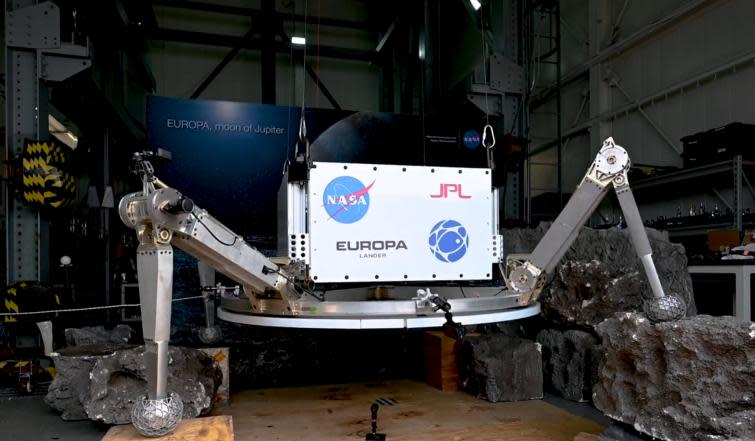Watch this Jupiter moon lander handle harsh terrain it may face on Europa (video)

Europa may be one of the most interesting spots in our solar system. This moon of Jupiter is believed to harbor a subsurface sea with twice the volume of all Earth’s oceans combined. For this reason, Europa may represent one of our best chances of finding life within our pocket of the cosmos.
With that in mind, in August, engineers at NASA’s Jet Propulsion Laboratory in Southern California tested a landing system for a hypothetical future mission to the icy Jovian moon.
Landing on Europa, like with any rocky world, is expected to have its challenges. Craggy terrain on the surface can make landing difficult, potentially tipping over or even damaging the spacecraft. Early rovers on Mars, such as Sojourner, Spirit and Opportunity, traveled to the Red Planet on spacecraft that utilized an airbag system for protection during landing. These airbags inflated as their respective spacecraft fell through the atmosphere, allowing the vehicles to bounce like balls until they finally stood still. Later rovers, such as Curiosity and Perseverance, utilized a "sky crane" system in which the landers were gently lowered to the Martian surface by a separate platform.
For a lander to Europa, engineers tested something akin to that sky crane mechanism. Their sky crane slowly lowered a spacecraft with four large legs, each with a knee" and "hip" joint over terrain built to simulate what might be found on Europa.
Related: Next stop, Europa? Nano subs to get test beneath Antarctic ice in 2026

As the craft got closer to the surface, these legs each individually encountered the ground below, bending and adjusting as necessary to keep the spacecraft, positioned between the legs, stable.
In sunny southern California, engineers specifically lowered the test lander onto assorted items as well, including — big wooden blocks, rocks and even to an exercise ball. The goal was to see how their sky crane design fared in a variety of situations.
Related Stories:
— James Webb Space Telescope detects 1st evidence of carbon on Jupiter's icy moon Europa
— Surprise! Jupiter's ocean moon Europa may not have a fully formed core
— Newly discovered type of salt could explain the mystery of Europa's ice cracks
The lander is built to stop its descent when the "belly" of the spacecraft, the area on the bottom of the spacecraft between the legs, encounters any terrain. This would lock the legs, keeping the spacecraft level. If the belly never encounters terrain within a set timeframe, the legs would eventually lock anyway to suspend the lander safely above whatever terrain lies below.
NASA has a plan to perform several flybys of Europa with its Europa Clipper, scheduled for launch on October 6, 2024. A lander to the icy moon is still a proposed, but highly anticipated, mission.

